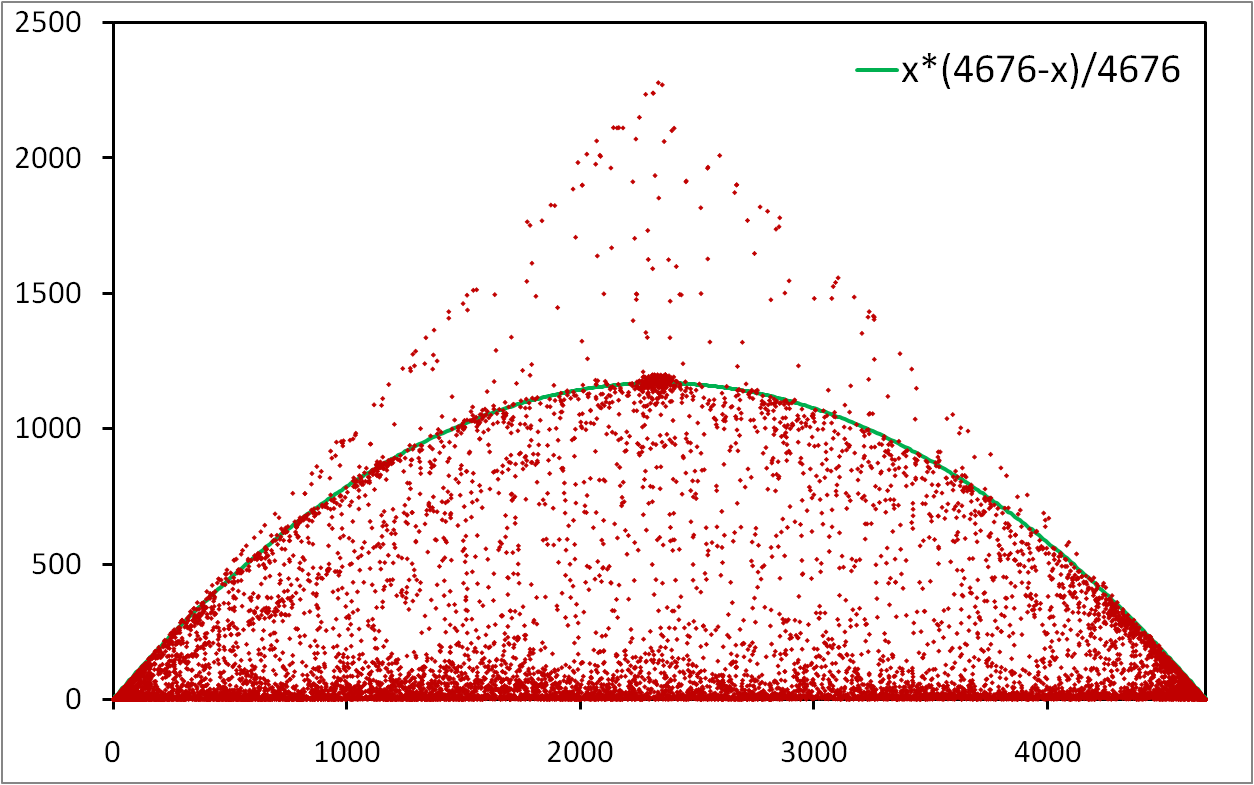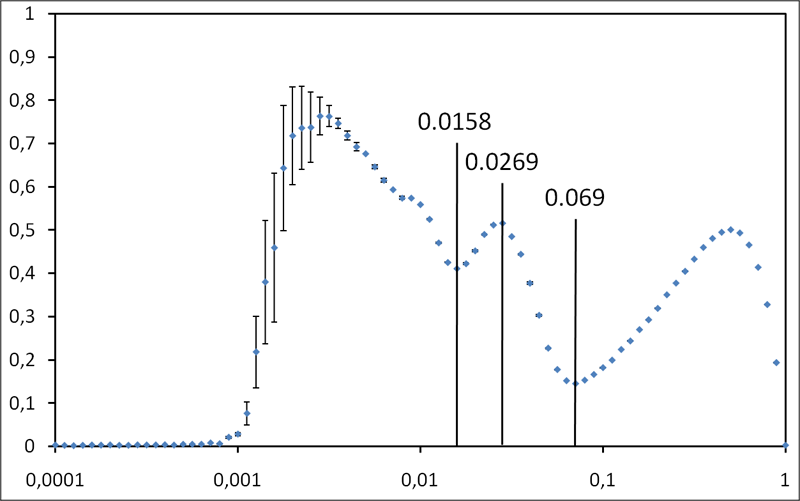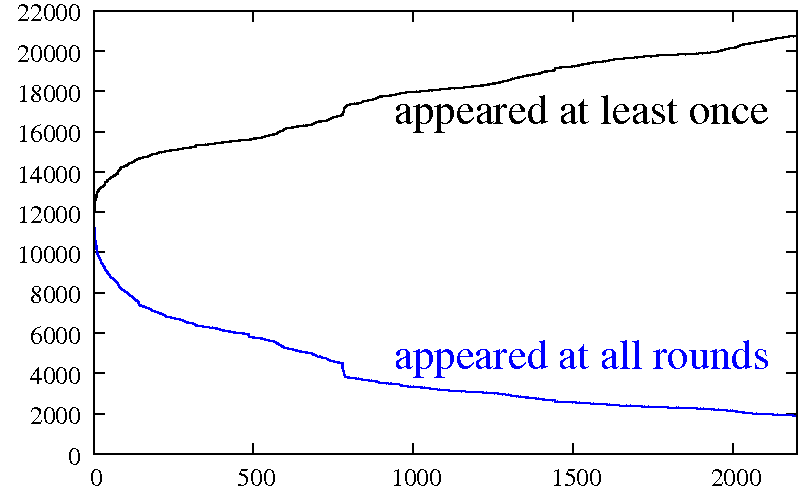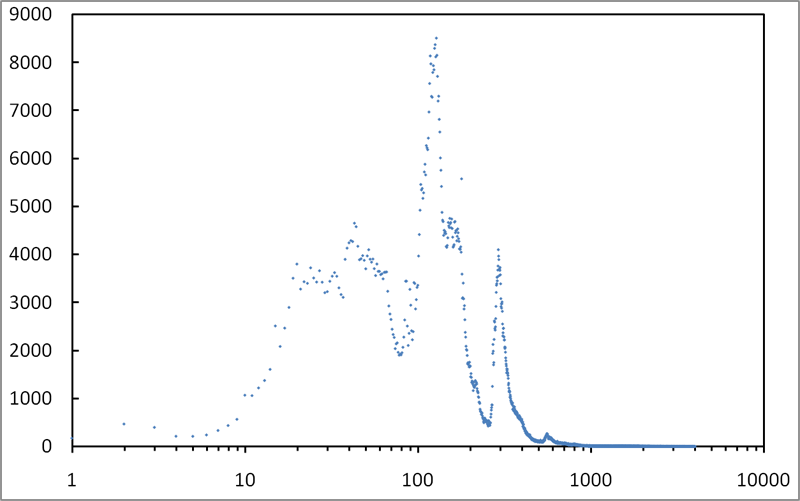Event detection around me
Dynamics of IP addresses around me
A Radar for the Internet
Matthieu Latapy, Clémence Magnien and Frédéric Ouédraogo
Proceedings of ADN’08: 1st International Workshop on Analysis of Dynamic Networks, in conjunction with IEEE ICDM 2008
In contrast with most internet topology measurement research, our concern here is not to obtain a map as complete and precise as possible of the whole internet. Instead, we claim that each machine’s view of this topology, which we call ego-centered view, is an object worth of study in itself. We design and implement an ego-centered measurement tool, and perform radar-like measurements consisting of repeated measurements of such views of the internet topology. We conduct long-term (several weeks) and high-speed (one round every few minutes) measurements of this kind from more than one hundred monitors, and we provide the obtained data. We also show that these data may be used to detect events in the dynamics of internet topology.
Detection, Understanding, and Prevention of Traceroute Measurement Artifacts
Fabien Viger, Brice Augustin, Xavier Cuvellier, Clémence Magnien, Matthieu Latapy, Timur Friedman, and Renata Teixeira
Computer Networks 52-5 (2008), pp. 998-1018. Extended abstract published in the proceedings of the 6-th Internet Measurement Conference IMC’06, 2006, Rio de Janeiro, Brazil
Test of time award IMC 2022
Traceroute is widely used: from the diagnosis of network problems to the assemblage of internet maps. Unfortunately, there are a number of problems with traceroute methodology, which lead to the inference of erroneous routes. This paper studies particular structures arising in nearly all traceroute measurements. We characterize them as « loops », « cycles », and « diamonds ». We identify load balancing as a possible cause for the appearance of false loops, cycles and diamonds, i.e., artifacts that do not represent the internet topology. We provide a new publicly-available traceroute, called Paris traceroute, which, by controlling the packet header contents, provides a truer picture of the actual routes that packets follow. We performed measurements, from the perspective of a single source tracing towards multiple destinations, and Paris traceroute allowed us to show that many of the particular structures we observe are indeed traceroute measurement artifacts.
Complex Network Measurements: Estimating the Relevance of Observed Properties
Matthieu Latapy and Clémence Magnien
Infocom’08 Proceedings, Phoenix, USA
Complex networks, modeled as large graphs, received much attention during these last years. However, data on such networks is only available through intricate measurement procedures. Until recently, most studies assumed that these procedures eventually lead to samples large enough to be representative of the whole, at least concerning some key properties. This has crucial impact on network modeling and simulation, which rely on these properties. Recent contributions proved that this approach may be misleading, but no solution has been proposed. We provide here the first practical way to distinguish between cases where it is indeed misleading, and cases where the observed properties may be trusted. It consists in studying how the properties of interest evolve when the sample grows, and in particular whether they reach a steady state or not. In order to illustrate this method and to demonstrate its relevance, we apply it to data-sets on complex network measurements that are representative of the ones commonly used. The obtained results show that the method fulfills its goals very well. We moreover identify some properties which seem easier to evaluate in practice, thus opening interesting perspectives.
Random graph exploration with shortest paths
Growth of the number of IP around me
RTT distribution
Describing and simulating routes on the Internet
Jérémie Leguay, Matthieu Latapy, Timur Friedman, Kavé Salamatian
Computer Networks 51, pages 2067-2087, 2007. Extended abstract published in LNCS, proceedings of the 4-th IFIP international conference on Networking, 2005, Waterloo, Canada
This contribution deals with actual routes followed by packets on the internet at IP level. We first propose a set of statistical properties to analyse such routes, which brings detailed information on them. We then use the obtained results to suggest and evaluate methods for generating artificial routes suitable for simulation purposes. This also makes it possible to evaluate various network models. This work is based on large data sets provided mainly by CAIDA’s skitter infrastructure.
Complex Network Metrology
Jean-Loup Guillaume and Matthieu Latapy
Complex Systems 16, pages 83-94, 2005
In order to study some complex networks like the Internet, the Web, social networks or biological networks, one first has to explore them. This gives a partial and biased view of the real object, which is generally assumed to be representative of the whole. However, up to now nobody knows how and how much the measure influences the results. Using the example of the Internet and a rough model of its exploration process, we show that the way a given complex network is explored may strongly influence the observed properties. This leads us to argue for the necessity of developing a science of metrology of complex networks. Its aim would be to study how the partial and biased view of a network relates to the properties of the whole network.
Relevance of Massively Distributed Explorations of the Internet Topology: Qualitative Results
Jean-Loup Guillaume, Matthieu Latapy and Damien Magoni
Computer Networks 50, pages 3197-3224, 2006. Extended abstract published in the proceedings of the 24-th IEEE international conference Infocom’05, 2005, Miami, USA
Internet maps are generally constructed using the traceroute tool from a few sources to many destinations. It appeared recently that this exploration process gives a partial and biased view of the real topology, which leads to the idea of increasing the number of sources to improve the quality of the maps. In this paper, we present a set of experiments we have conducted to evaluate the relevance of this approach. It appears that the statistical properties of the underlying network have a strong influence on the quality of the obtained maps, which can be improved using massively distributed explorations. Conversely, some statistical properties are very robust, and so the known values for the Internet may be considered as reliable. We validate our analysis using real-world data and experiments, and we discuss its implications.






